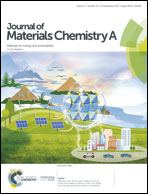Understanding the role of functional groups of thiolate ligands in electrochemical CO2 reduction over Au(111) from first-principles
Abstract
Thiolates have long been used as ligands for protection of Au. However, how the presence of thiolates influences the CO2 reduction reaction (CO2RR) over Au(111) remains elusive. In this work, the role of functional groups of thiolates is systematically investigated by DFT calculations, and three representative types of groups with different proton-donating abilities (pyridine, –NH2, and –COOH) are considered. In particular, it is revealed that the 4-pyridinylethanemercaptan (4-PEM) ligand can be favorably protonated, and the coupled pyridine-H-and-surface-H transfer would effectively promote the activation and conversion of CO2 to HCOOH. The –NH2 group of the cysteamine (CYS) ligand would coordinate with surface Au and prevent its further protonation, where the localized electronic effect and hydrogen bonding play an important role in stabilizing the chemisorbed CO2 that would facilitate CO formation. The 2-mercaptopropionic acid (MPA)-modified Au(111), however, shows unique activity for the HER while suppressing the CO2RR, due to the higher surface concentration of H2O from hydrogen bonding interaction between deprotonated –COO− and H2O as well as the destabilization of chemisorbed CO2. The theoretical findings provide a mechanistic rationale of the recent experimental finding, and offer useful guidelines in future design of ligand modifiers to tune the CO2RR over Au and other metal systems.



 Please wait while we load your content...
Please wait while we load your content...